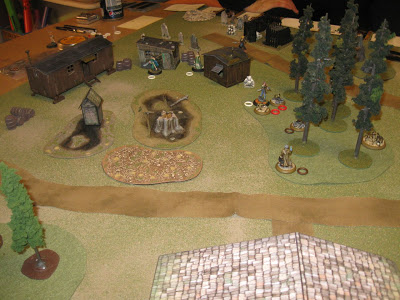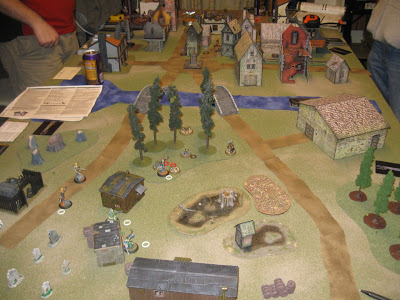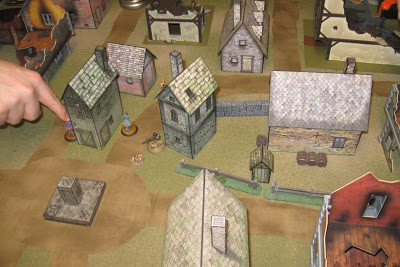 |
| Matched pairs, 15mm games |
JM and I volunteered to run a DBA Matched Pairs event on Saturday morning. Neither of us got a lot of sleep the night before, so when I woke up I just let JM sleep in and started the event without him.
I posted details on Fanaticus, but here’s a summary of the results. We had 16 players in two brackets. 4 players used “hybrid” basing, which uses 15mm figures with the 25mm base sizes for more visual appeal. One player had 6mm figures on 15mm bases, and the rest brought straight 15mm figures.
Since each player provides two armies that will play against each other, any scale can be used as long as they’re compatible.
Jason Bostwick won group A with 71 points (3 wins, 1 loss), and Ted Furey went undefeated in group B with 89 points.
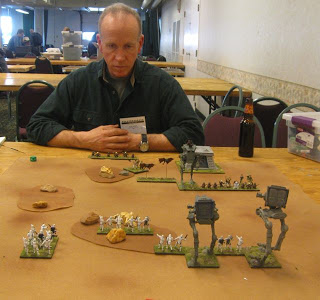 |
| May the Beer be With You: Rick Wynn, HOTT matched pairs. |
Next was Hordes of the Things matched pairs. I brought my Battle of Endor “matched” pair built from Star Wars collectible miniatures. This was not an even match, but it produced historical results. I need to work on the army composition before bringing it out again.
In the first round, I faced Alex Bostwick using my army. He chose the Rebels and Ewoks, and I played the Imperial side. He crushed me quickly, I believe it was 6g-0. Shooter generals are feeble, but it was too late to change my mind.
Next I played against Jeff Franz using his Perseus vs. Medusa Greek armies in 15mm scale. I had Perseus fly behind his line with a harpy to strike his harpy in the rear and kill it. Unfortunately, in response Medusa turned around and shot Perseus down, recoiling him into his own harpy and killing him. I lost 6g-2 after 2 rounds of combat.
In the third round, Rick Wynn also chose to play the role of the Ewoks. This game lasted a bit longer, but ended the same way: my shooter general was crushed and the Empire fell. It was approximately 8g-0 at the end. Hmm, I have a problem losing generals, apparently.
Finally, I faced Greek Alex who was borrowing a pair of “Arabian Nights” armies from Rick. They were identical: a Magician general, flyer, dragon, behemoth, and warbands. These are PIP intense forces, but it evens out when they face each other. Alex whittled me away, got his dragon on the board, and finally ended up winning 14-0.
Once again, I felt a need to learn how to play HOTT effectively. The troop interactions are fun, but also new and different, and not what I’m used to. I ended up picking up prepainted Mechwarrior figures for another HOTT matched pair of armies, so I’ll have more armies to choose from if I ever find the time to play.
Finally, the event we’ve all been waiting for: Condotta Chaos! As usual, the Two Davids campaign event was the highlight of the convention.
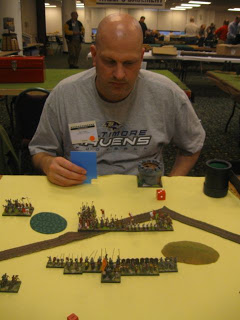 |
| Jeff Franz, looking down. |
By the time this event started, I had been running on too little sleep for a long time. I was basically on autopilot by now. Luckily the event was run using the DBA 2.2+ rules, which I seem to be more familiar with these days.
I originally intended to take Pike and Artillery as my army options, but then I learned none of the Condotta armies were allowed to take pike. Since I needed to take spears, I took psiloi to provide support for them. My other options were an additional Light Horse, and of course the pavisiers.
In this event, all knights were allowed to dismount as blades at deployment. I painted blades for this, so I hoped to get a chance to use them.
In the first round, I drew a high numbered chit, and defended against Jeff Franz’s Condotta. I placed terrain, and used a road curved around a hill and a wood. I deployed with two Knights dismounted as Blades near the bad going to act as bad going troops. He very helpfully placed his Artillery on the same flank, and I sensed an opportunity.
This was the only game when I took advantage of a 2.2+ rule that I remembered but the enemy forgot. He kinked his line, so I contacted his ungrouped Artillery and caused it to conform to my column of blades so I could fight it without an overlap. It wasn’t without risk: I had to survive one round of combat against a knight before I could get back into bad going. With the threat from his artillery neutralized, our lines clashed and I eventually crushed him and killed his general: 4g-2.
In this campaign, losing a general meant rolling on a table to see whether the general escaped (no effect), was captured (the only way for a winning defender to gain a vassal), or killed (causing the army to lose their vassals). Jeff’s general escaped alive but embarrassed. Fooey, I could use a good vassal!
 |
| Jan Spoor, looking down. |
In the next round, I got to choose between two high numbered tiles and so I was attacked again. This time I faced Jan Spoor and his… wait for it… Condotta! He used the same composition that I had.
I rolled as the defender and placed similar terrain: minimal bad going with enough room between them to play, and a bent road. I deployed all my knights mounted, and left two elements of bait to the left of the woods. He deployed three elements on that flank and took the bait! Oh wait, he also brought his General with him so he wouldn’t be out of command. That wasn’t part of my plan…
In the end, it was a very close, hard fought battle. He had superiority on the left flank, but I managed to kill enough in the center that I pulled off a 4-3 victory before I died. Once again, since I was defending, I didn’t gain any vassals.
 |
| Rick Wynn, looking down. |
In round 3, I drew two tiles again since I won, and once again my numbers were too high to attack with. Rick Wynn attacked me with his Medieval Germans.
I defended, placed very similar terrain again, and once again placed two elements of bait on the left flank. This time they were on a road, making them look extra fancy in their steel stirrups and poofy sleeves. I deployed one knight dismounted, since Rick had more heavy foot than I did. He also took the bait, but he took an entire spear quad to counter it. This was great news. As long as I could threaten them enough not to move back to the center, I was confident I’d never need to face them.
It was either this game or the previous one when I finally figured out how to wheel my army into advantageous matchups effectively. In this game it really clicked and worked well. I swapped my elements into place so that it was in Rick’s benefit to walk forward, and in my interest to wheel into a better position, and it just worked really well.
But Rick is a good player, and he did a very good job of protecting his flank with the woods on his side. I managed to hit his line hard enough to do some damage, but after my initial combat advantage I started taking casualties. Pretty soon I was only one element from dying, but I managed to kill his general and win 4g-3. In the end, two of my elements and one of his had done a 180 in the middle of the board, it was a real mess.
This game demonstrated the difference it makes when you don’t lose rear support when a front rank dies in 2.2+. My psiloi support survived at least 2 rounds of combat against his knight, but eventually lost a 2-2 mutual quick kill roll. A Knight killing spears and following up into a Psiloi with double overlaps is not necessarily a good deal for the Knight… it’s certainly dangerous, possibly too dangerous.
Since Rick lost his General, he had to roll on the CMAT table as well, and I captured him. A vassal at last!
 |
| Mark Pozniak, looking down. |
In the final round, I drew the 1 and 2 tiles. Finally I got to attack, and so did Rick. I had a tiny vassal tree compared to other players, but they did look like juicy targets. I hadn’t played against Poz yet, and he had a big vassal tree that I could reach easily, so I attacked him.
Mark had Condotta, and I think he took Artillery. He defended and placed terrain. It looked similar to mine, but with the bad going farther apart and larger. He also placed two elements of light horse on a flank, and I mirrored his deployment there.
Again this game, I was able to wheel into good matchups with the main line. I struck his light horse with mine at just about the time our lines met, but it was a minor mistake: I should’ve waited for him to come to me so he’d be out of command radius.
I killed one of his light horse immediately, and this time I didn’t lose my early combat advantage. I won combats all down the line and fairly quickly killed him 4-0. It was a much faster game, but much less tense than the previous ones.
This win netted me a large vassal tree, and Rick added to it with his attack as well. In the end, first place was a three way tie between me, Mark, and Rich Baier. We had a roll-off to break the tie before Dave Schlanger had a chance to tell us who was actually eligible, but everyone else had so many plaques they just let me take it anyway.
So finally, I started winning! I guess it was better that it was all in one event; now I’m qualified for the NICT and have a measurable reason to try to get to Historicon in July. We’ll see if my schedule allows it.
Saturday night, we stayed up until 4:30am after the Daylight Savings clock change, playing Red Dragon Inn. This was quite a fun little Take That! game, with a good theme. But as with most of these games, it is nothing without its theme and the right players to make the most of it. It’s not a good choice for our gaming group in Pittsburgh, but it was a lot of fun to play with the rowdier convention crowd.
Those games produced my favorite quote of the convention, courtesy of Alex Bostwick: “Hey guys! Alan is secretly 40!” Well, just because you don’t tell anyone something, that doesn’t necessarily make it a secret, but I’m old enough to appreciate it when someone thinks I’m in my 20’s.
Thanks to everyone for running these excellent events! I had fun, as always, and look forward to seeing everyone again.


















